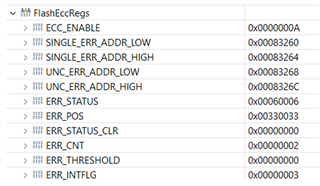Hi Experts,
In our application, we need to transition from the application code to the bootloader code using assembly language, specifically with the instruction asm(" LB 0x8349b");. Please note that the address may vary.
Our application code initializes the Vector Table interrupt, which also sets up the Non-Maskable Interrupt (NMI). The Error Correction Code (ECC) is also activated during program initialization.
After invoking asm(" LB 0x8349b");, the NMI is triggered, and the NMISHDFLG register displays FLUNCERR. This indicates that the Flash Uncorrectable Error NMI Flag is set.
Should the ECC of this chip be deactivated before jumping to the specified address? Or is there any other reason that could cause the NMI to be triggered?
Thanks,
Best Regards,
C.C. Liu


